
Aquarium Systems created a new series of freshwater and marine LED bars, and today we have the new ceiling light ASF Reef Blue 90-120 cm for marine aquariums in our DaniReef LAB.
LED bars are the best and most convenient way to manage the light in your aquarium. They’re reasonably cheap and they can be gradually purchased until you have enough, depending on your needs. Maybe one for the fish, a couple for soft corals, and more for LPS and SPS. Opposed to a conventional lighting system, you can’t dim the LED channels, but you can overcome this problem by turning on the bars singularly. Besides, today you can buy external controllers to dim the bars individually. Maximum ease and customization, as if we had a much more complete lighting system.
Technical characteristics of the LED ASF Proten LED Reef Blue bars
- Driver: external;
- Input Voltage: 230VAC;
- Frequency: 50-60Hz;
- Power consumption: 27 watts;
- Length: 90 cm;
- Price for the public: 129,99 euro ($146 USD).

LEDs in the bar
- Purple LED 400 nm: 12
- Blue LED 420 nm: 48
- Blue LED 460 nm: 84
- Blue LED 680 nm: 6
- Blue LED 700 nm: 6
Total LEDs: 156. Given the declared power consumption, which is 27 watts, they are 0.15 watt LEDs, considering some watts are being used for the electronic control.
Our video of the ASF Proten LED Reef Blue 90-120 bars
In this video we show the bars and how we do the PAR measurement. The video is in Italian, but you can turn the English subtitles on. Enjoy!
A unique feature of the ASF Proten LED Reef Blue
These LED Blue bars have the main part of their LED included in the Blue domain, about 90%. Still, they have a small portion of LED in the Red domain. This choice has been made in order to bring out the corals’ fluorescence while keeping an almost completely blue illumination. The lamp has 2 independent channels which are activated with a convenient two-way switch.
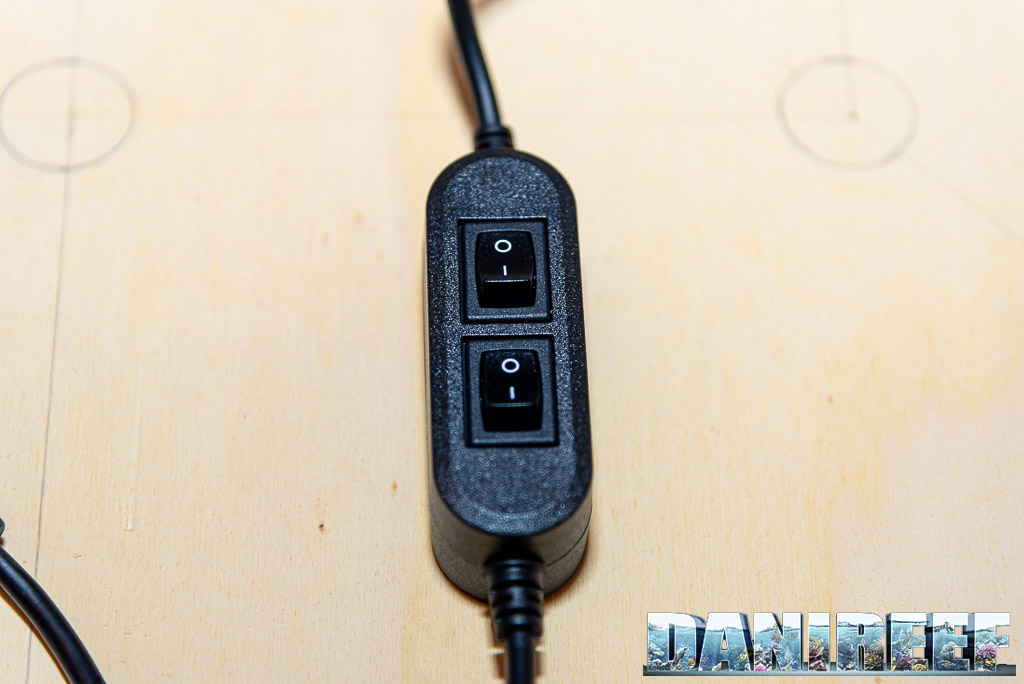
An external bluetooth controller is also available that can manage two independent lamps, and that also allows you to dim the channels of each LED bar. But today we’re looking at the bar without the controller.
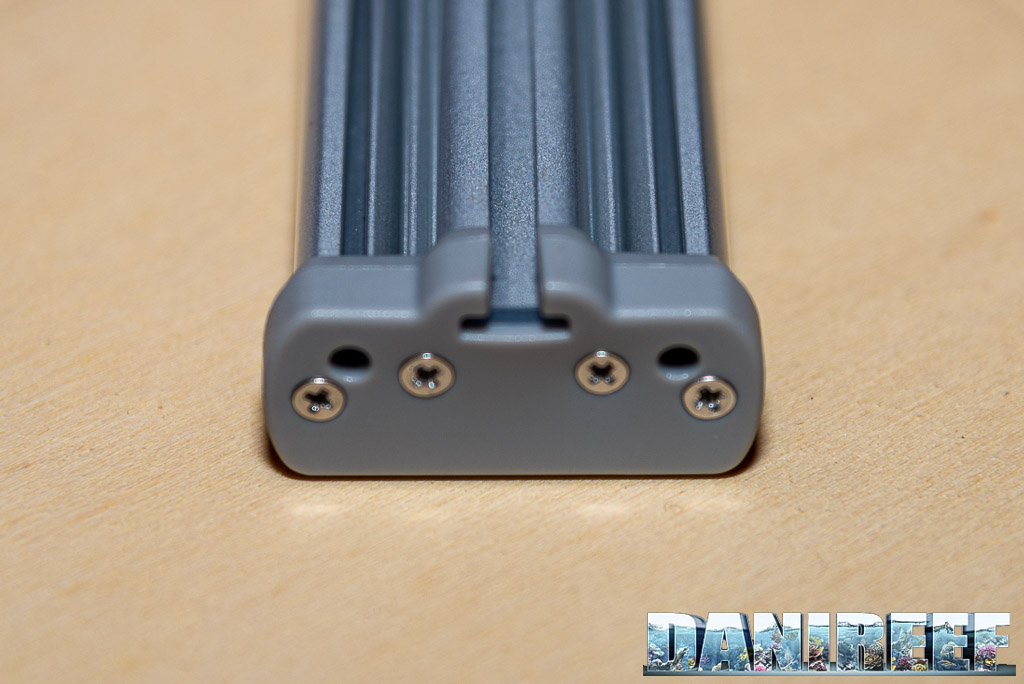
The Proten LED of the ASF has two holes on the top, as you can see in the picture, to which you can connect two metal terminals for hanging the bars on the glass of the aquarium. On the top of the terminals you have to insert some plastic clips so that the lamps don’t touch the glass. The package includes other clips that fit perfectly for the installation in a T5 or T8. In our video you can see how to install the terminals, so don’t miss it!
Thanks to these terminals you can use the Proten LED Reef Blue bar in aquariums between 90 and 120 cm of length.
Our new DaniReef LAB working method for PAR measurement
During the long nights spent on our forum (here) we always wondered how could we compare PAR from different ceiling lights. Even though we had the perfect device, the Quantum Meter MQ-510 by Apogee, we only look at the value measured at the center at 20 cm of distance, more or less.
The Quantum Meter MQ-510 measures the PAR, expressed in PFFD, which is photosynthetic photon flux density in μmol m-2 s-1. This device is calibrated to work underwater, so if it’s in air the measured value has to be divided by 1.32, the dive factor. We have to do the conversion. The values you’re going to see are correct.
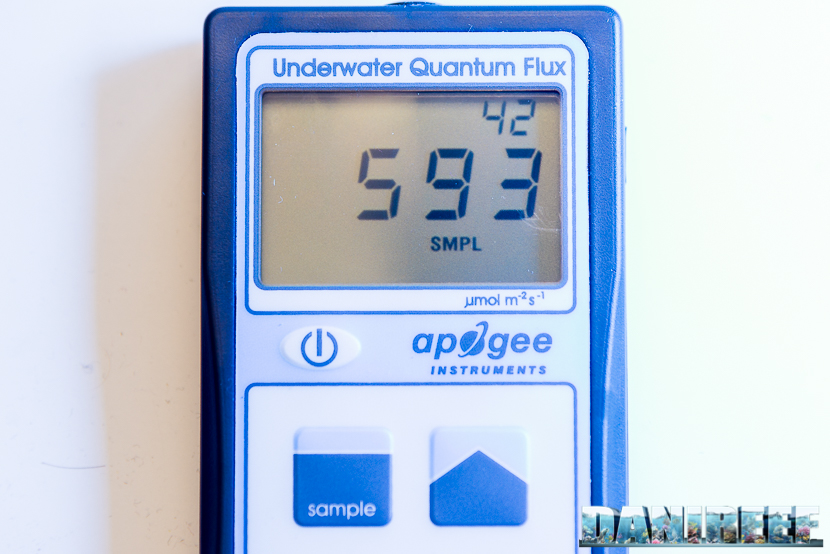
We decided to make a square base of 70×70 cm, we set 17 fiducial points where we placed the sensor Quantum Meter MQ-510 and we also made 3 lifts of 20, 40 and 60 cm for the ceiling light, in order to have the same distance from the sensor. This will allow us to create the curves which can be compared to other ceiling lights, all tested at the same distances. Note that this distance is measured between the base of the sensor and the ceiling light. In reality it should be decreased by 3.5 cm, which is the height of the measurement cylinder and increased by 0.5 cm, which is the dimension of the spacers that lift the ceiling light.
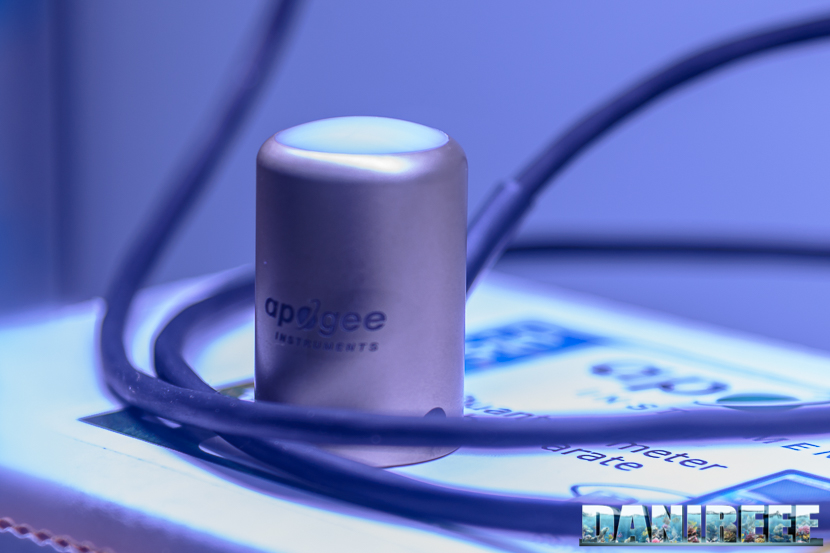
So the three measurements are made at distances of 17, 37 and 57 cm. Because they’ve been done in air, they will be corrected.
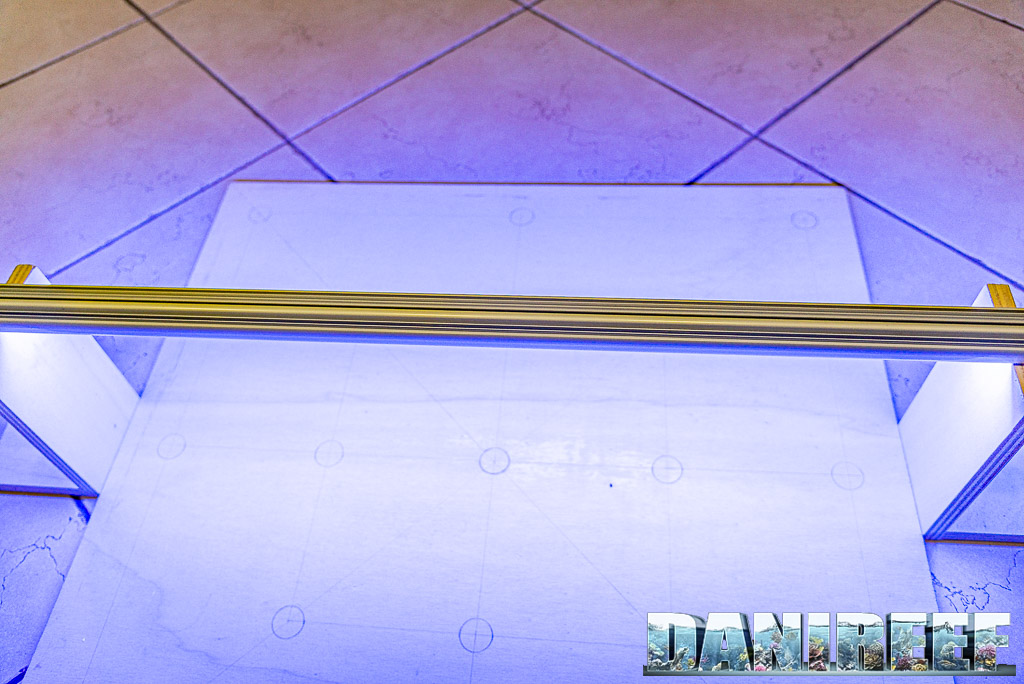
Above you can see our base with the spacers that keep the LED bar raised by 17 cm between the base and the lamp itself, so that we’ll have the same value for every ceiling light we test and the comparisons will be easier.
PAR measurement at 17 cm
These are the collected values:
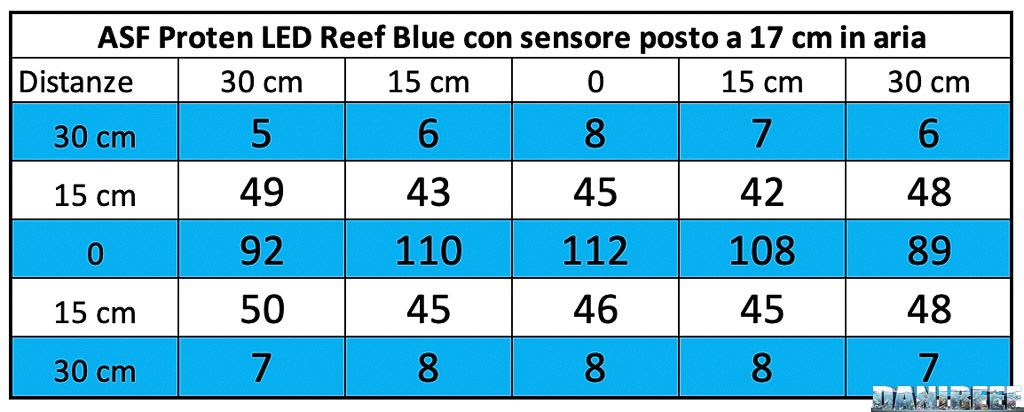
And this is the corresponding chart. We are using the same scale for lights of the same class. In this case, speaking of bars, we lowered the maximum scale. For the bars we test in the future, you’ll find the same evaluation scale.

As you can see, the bar creates a curve similar to a tent and obtains a perfect uniformity between the values at the middle on the sides. Different from classic lamps, the decrease is very linear, at 20 cm from the light source. Note that on the sides the light slightly decreases: that’s normal because it doesn’t have the reinforcement of the central light.
PAR measurement at 37 cm
Here are the collected values:
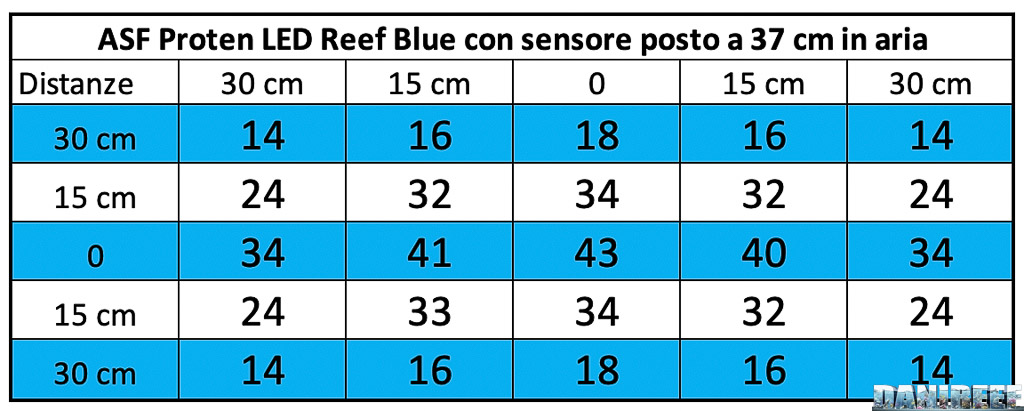
And this is the corresponding graph.
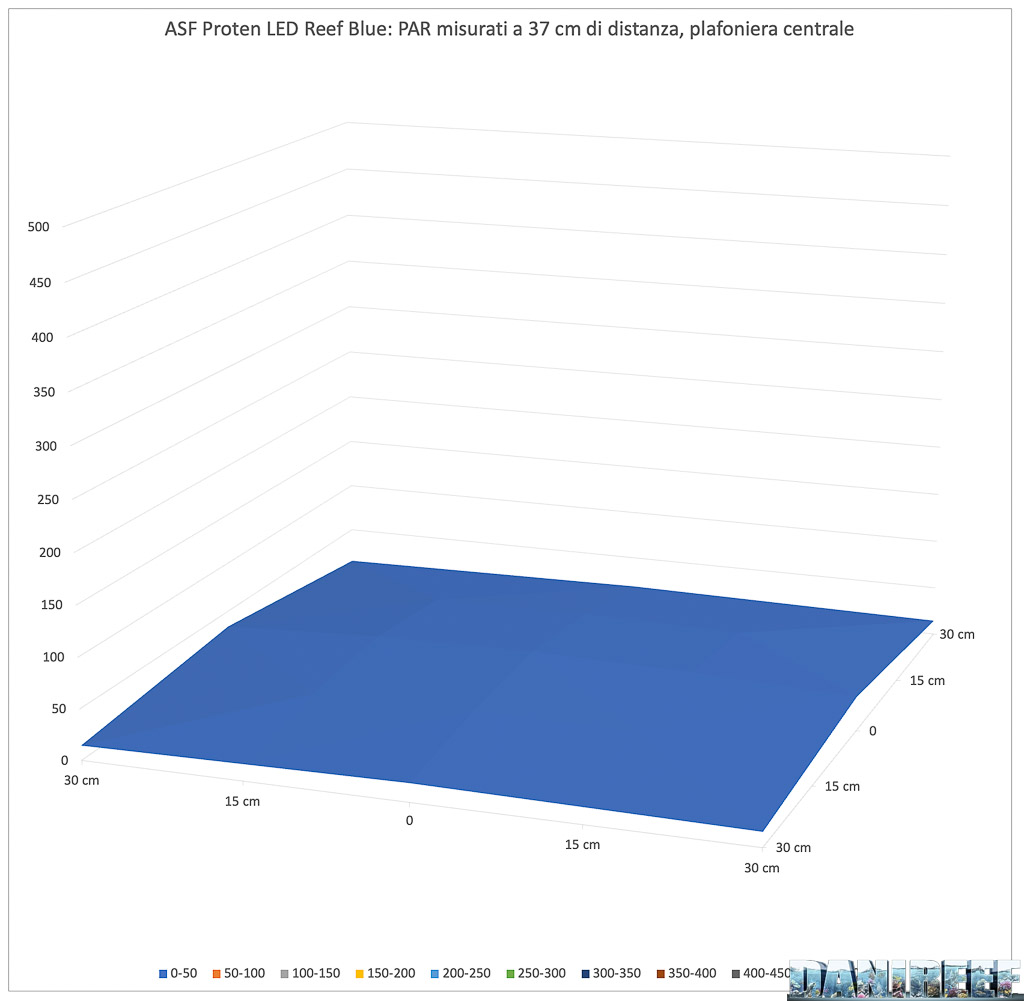
With a bigger space between ceiling light and sensor, the difference between PAR at the middle and on the sides decreases. The light spreads a lot, but the value at the middle decreases from 112 to 43 μmol m-2 s-1, measured at the brightest points.
PAR measurement at 57 cm
These are the collected values:
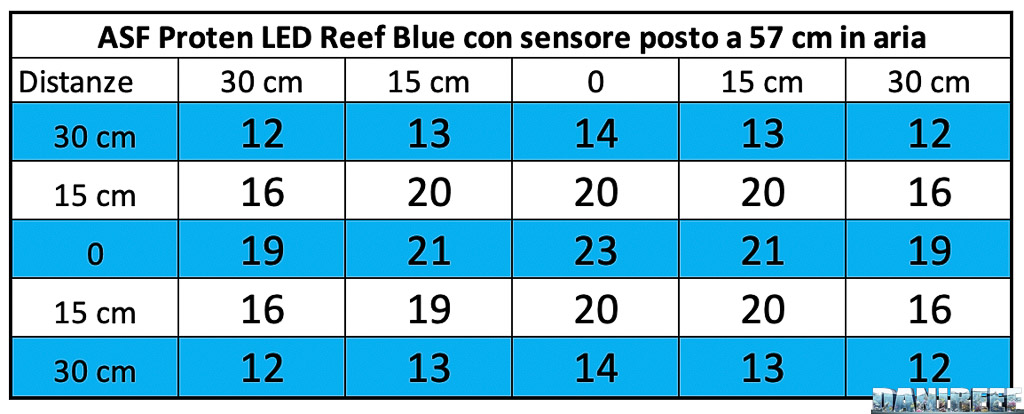
And this is the corresponding chart:
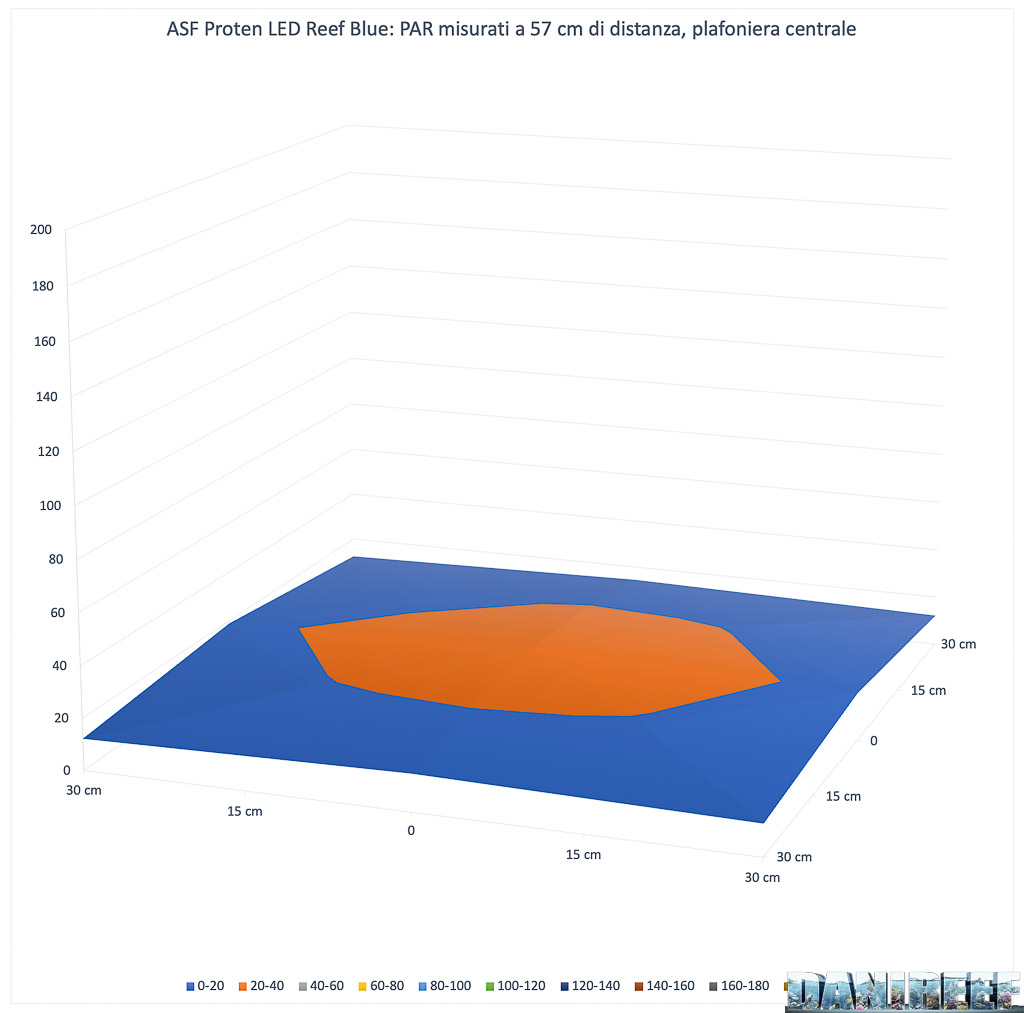
Increasing the space between ceiling light and sensor even more also increases the uniformity among the collected values. The uniformity is practically perfect. The value at the middle decreases again from 112, to 43, to 23 μmol m-2 s-1.
The PAR in the middle with different configurations
Let’s continue with our technical measurements. We can see how, in a chart, the PAR collected in the middle decreases at the three different distances of our tests.
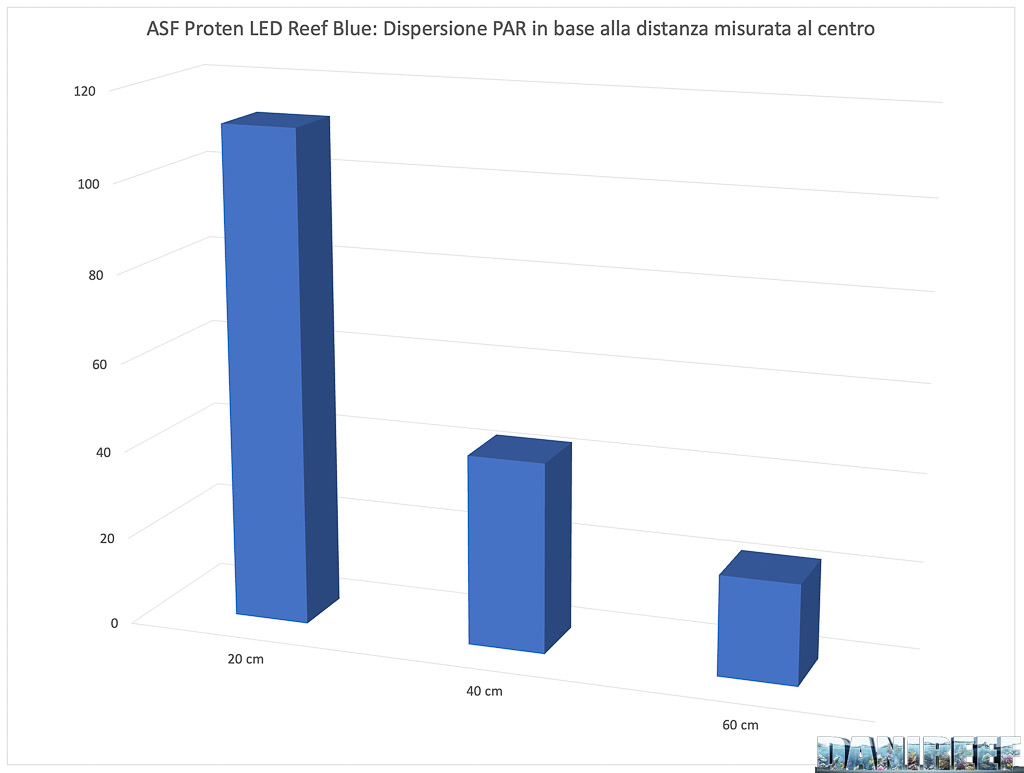
Energy variation of the Reef Flare Pro L Blue depending on the distance

This is the most significant and most useful comparison: the energy variation. We calculated the volumes of the three surfaces previously seen. It’s obvious that moving away from the ceiling light, the PAR decreases, but the light illuminates a wider space. In this way you can consider all the light energy contained in the 60×60 cm area subtended by the ceiling light. And the three values of 138,000, 93,000 and 60,000 assume a different connotation compared to the values in the middle. When the first ones decrease because of the increase of the distances, the subtended area, that is the energy, decreases slowly.
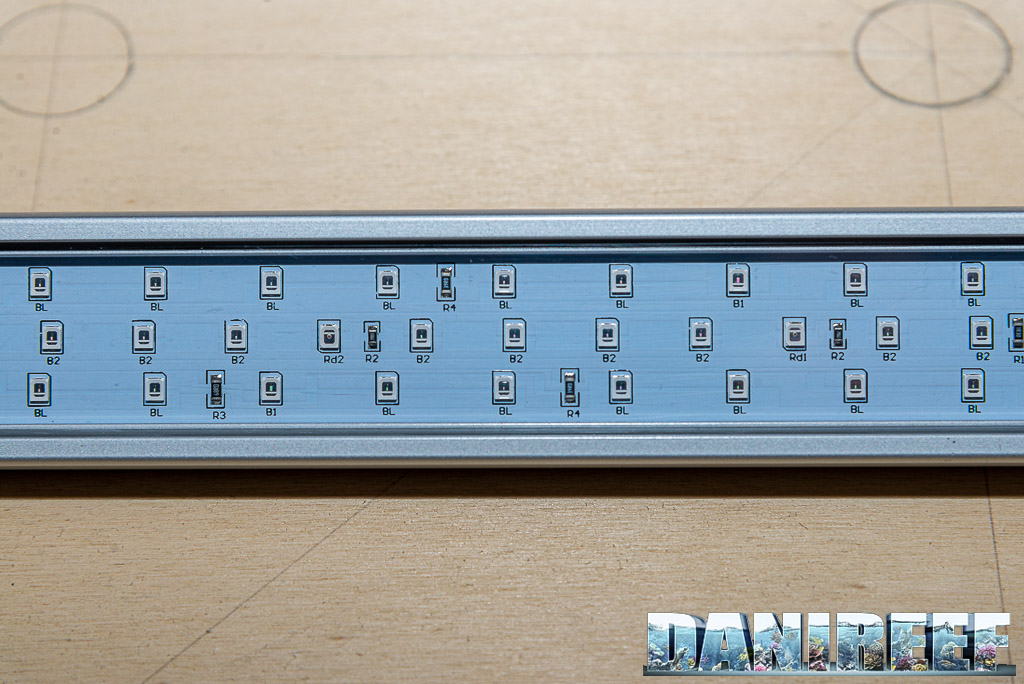
How to value these numbers in aquarium?
This is a good question. At first we thought that we could transport these values to the aquarium tout-court. Then we filled the aquarium, inserted the probe and redid the measurements. We were fazed but, as we have already said in elsewhere, we’re going to talk about this in another article. Basically, while at 20 cm the result is practically the same, as we progressed, thanks to the glass and the water itself reflecting the light, we found even the double of the values measured in air. Obviously this isn’t a detail that can be standardized, so we think that our method of calculation is the most correct, and the best for the comparison of coverages of different ceiling lights.

Power consumption
The measurement of the consumption was made possible thanks to the useful RCE PM600 that can also measure the Cos(fi) (or power factor). The result is already given in watts.
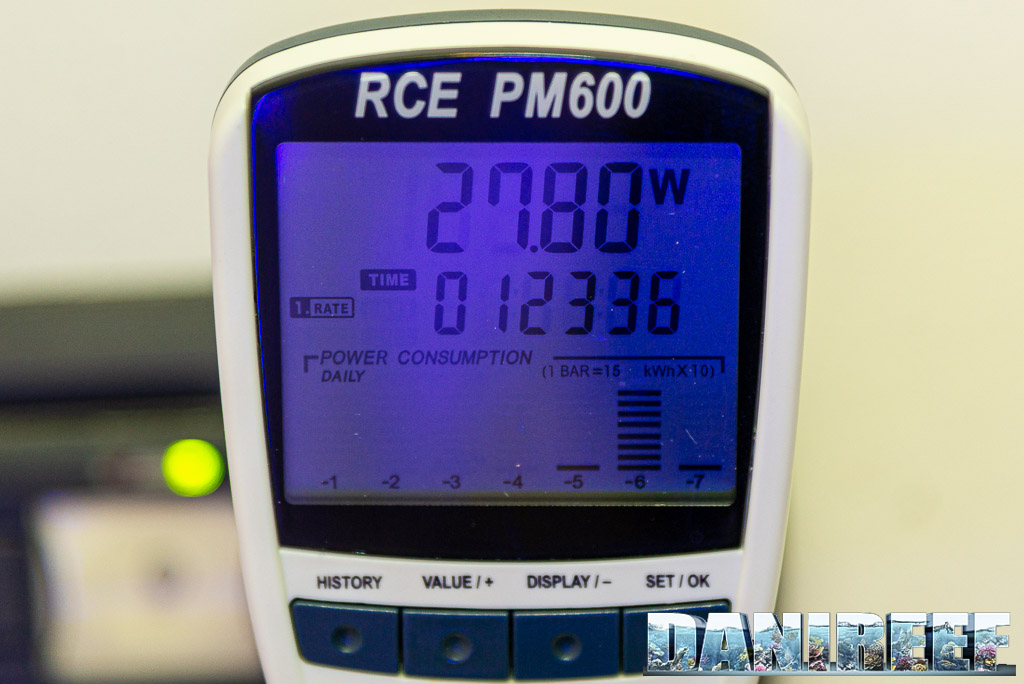
Pictured above is the maximum power and below is the Cos(fi).
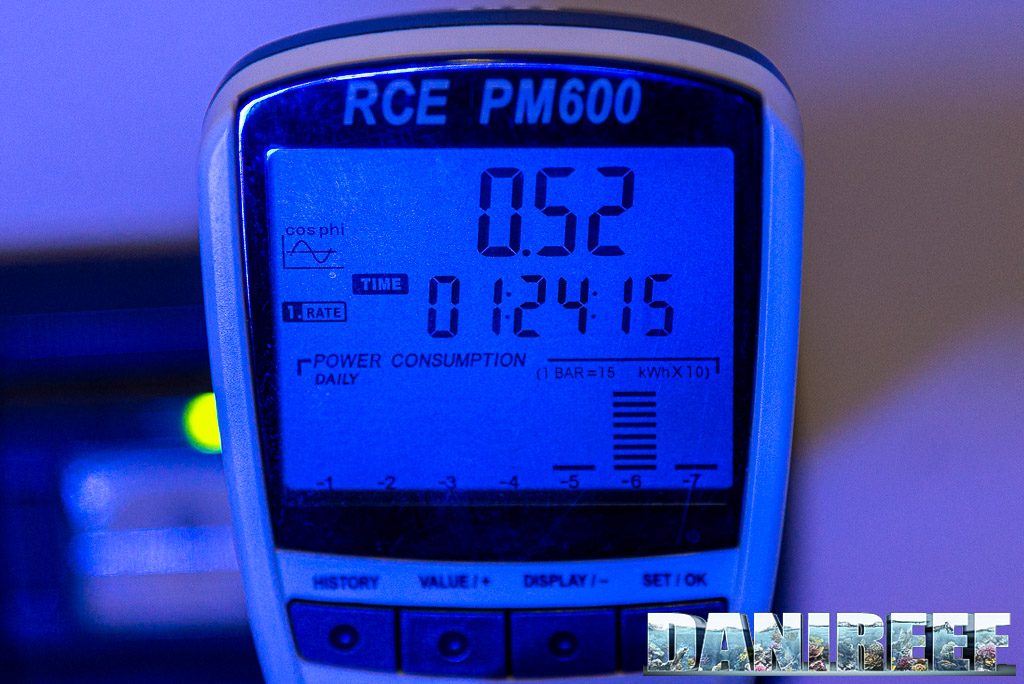
The calculation of the current absorbed, that is the power, is as follows:
The Proten LED Reef Blue 90-120 consumes 27.80 watts. Considering that at 17 cm the light has 11211 μmol m-2 s-1 in the middle, we can say, in perspective, that it has a peak value of 4,03 μmol m-2 s-1 w-1 (PAR per watt). This value is hardly comparable with other lights because it remains more or less constant throughout the length.
We have to consider a Cos(fi) of 0.52: on average, considering the kind of lamp.
The comparison with other ceiling lights on the market
Here is the data collected in the DaniReef LAB with the Quantum Meter MQ-510 by Apogee. We can do an interesting comparison of the power of the ceiling lights:
| Energy | Cost | Power consumption | Energy/€ | Energy/w | |
| ASF Proten LED Reef Blue at 17 cm | 138.000 | 130 | 27,80 | 1.060 | 4.956 |
| ASF Proten LED Reef Blue at 37 cm | 93.000 | 130 | 27,80 | 718 | 3.357 |
| ASF Proten LED Reef Blue at 57 cm | 60.000 | 130 | 27,80 | 464 | 2.166 |
| Orphek OR2 Blue Plus 120 cm at 17 cm | 323.000 | 180 | 54,69 | 1.794 | 5.906 |
| Orphek OR2 Blue Plus 120 cm at 37 cm | 291.000 | 180 | 54,69 | 1.616 | 5.321 |
| Orphek OR2 Blue Plus 120 cm at 57 cm | 259.000 | 180 | 54,69 | 1.438 | 4.736 |
| Orphek OR3 Blue Sky at 17 cm | 318.000 | 200 | 62,04 | 1.590 | 5.129 |
| Orphek OR3 Blue Sky at 37 cm | 220.767 | 200 | 62,04 | 1.103 | 3.449 |
| Orphek OR3 Blue Sky at 57 cm | 205.518 | 200 | 62,04 | 1.027 | 3.211 |
| Orphek OR2 Reef Day Plus 120 cm at 17 cm | 255.000 | 180 | 54,69 | 1.418 | 4.667 |
| Orphek OR2 Reef Day Plus 120 cm at 37 cm | 233.000 | 180 | 54,69 | 1.292 | 4.252 |
| Orphek OR2 Reef Day Plus 120 cm at 57 cm | 225.000 | 180 | 54,69 | 1.251 | 4.117 |
| Reef Flare Bar Blue S at 17 cm | 202.000 | 220 | 24,34 | 918 | 8.299 |
| Reef Flare Bar Blue S at 37 cm | 177.000 | 220 | 24,34 | 804 | 7.272 |
| Reef Flare Bar Blue S at 57 cm | 155.000 | 220 | 24,34 | 704 | 6.368 |

The comparison is very interesting. These bars, compared to the competitors, are cheaper and consume less. This also leads to average values for the technical efficiency, but the economic efficiency is still pretty good.
Maintenance costs
The ASF Proten LED Reef Blue 90-120 bars cost 129,90 euro ($146 USD) on ASF’s official site.
The absorbed power is 27.80 watts, so it has a cost/watt ratio of about 4,67 euro per watt. For a comparison with the other ceiling lights you can consult the following chart.
| Lamp | Price | Power consumption | Euro per watt ratio |
| Orphek OR3 Blue Sky | 200 USD | 62 w | 3,2 euro per watt |
| Orphek OR2 Blue Plus | 180 USD | 54.7 w | 3,3 euro per watt |
| Orphek OR2 Reef Day Plus | 180 USD | 54,7 w | 3,3 euro per watt |
| Cetus 2 | 215 € | 60,7 w | 3,5 euro per watt |
| Philips Coralcare 2019 | 749 € | 190 w | 3,9 euro per watt |
| Maxspect Ethereal | 500 € | 126 w | 4,0 euro per watt |
| ASF Proten LED Reef Blue 90-120 | 130 € | 27,8 w | 4,67 euro per watt |
| Radion XR30w G2 PRO | 790 € | 170 w | 4,7 euro per watt |
| AI Hydra 32 HD | 430 € | 90,5 w | 4,75 euro per watt |
| Radion XR30w G4 PRO | 915 € | 190 w | 4,84 euro per watt |
| OceanLed Sunrise 600 | 870 € | 180 w | 4,8 euro per watt |
| Orphek Atlantik V4 | 1099 € | 226 w | 4,9 euro per watt |
| Radion XR30w G2 | 690 € | 140 w | 4,9 euro per watt |
| Radion XR30w G4 | 760 € | 150 w | 5,1 euro per watt |
| Aqamai LRM | 465 € | 87,5 w | 5,1 euro per watt |
| Zetlight UFO ZE-8000 | 500 € | 91,5 w | 5,5 euro per watt |
| Aqamai LRS | 289 € | 47,6 w | 6,1 euro per watt |
| Reef Flare Bar Blue S | 220 € | 24,34 w | 9 euro per watt |
| CEAB Slide & Led | 2.700 € | 275 w | 9,8 euro per watt |
| Sicce GNC 466 | 1.592 € | 120 w | 13,3 euro per watt |

The ceiling light is very well built, and the technical efficiency (PAR per watt) is very good. The cost per watt is great, so much that it has a relatively high position in our list of tested lamps. This allows us to use one or two of them in a first installation, with maybe fish and soft corals, at a low expense, but also have the possibility to choose the channels to be kept on. But you can also increase the number of bars to keep more demanding corals. I really like the extruded profiles, as well as the finishing, and it’s very interesting that they can adapt to ceiling lights of different lengths and be inserted in neon light lamps like the T5 and the T8. The ceiling lights are IP67.

Questions and comments, as usual, are very welcomed.
The ASF Proten LED Reef Blue bar have been provided by Aquarium Systems for this test.
[translated by Agnese Poggi]










0 Comments